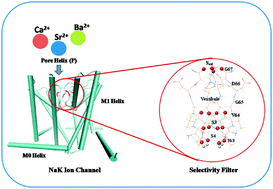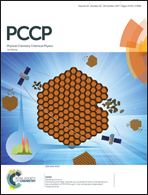Divalent ions are potential permeating blockers of the non-selective NaK ion channel: combined QM and MD based investigations
Abstract
The bacterial NaK ion channel is distinctly different from other known ion channels due to its inherent non-selective feature. One of the unexplored and rather interesting features is its ability to permeate divalent metal ions (such as Ca2+ and Ba2+) and not monovalent alkali metal ions. Several intriguing questions about the energetics and structural aspects still remain unanswered. For instance, what causes Ca2+ to permeate as well as block the selectivity filter (SF) of the NaK ion channel and act as a “permeating blocker”? How and at what energetic cost does another chemical congener, Sr2+, as well as Ba2+, a potent blocker of the K+ ion channel, permeate through the SF of the NaK ion channel? Finally, how do their translocation energetics differ from those of monovalent ions such as K+? Here, in an attempt to address these outstanding issues, we elucidate the structure, binding and selectivity of divalent ions (Ca2+, Sr2+ and Ba2+) as they permeate through the SF of the NaK ion channel using all-atom molecular dynamics simulations and density functional theory based calculations. We unveil mechanistic insight into this translocation event using well-tempered metadynamics simulations in a polarizable environment using the mean-field model of water and incorporating electronic continuum corrections for ions via charge rescaling. The results show that, akin to K+ coordination, Sr2+ and Ba2+ bind at the SF in a very similar fashion and remain octa-coordinated at all sites. Interestingly, differing from its local hydration structure, Ca2+ interacts with eight carbonyls to remain at the middle of the S3 site. Furthermore, the binding of divalent metals at SF binding sites is more favorable than the binding of K+. However, their permeation through the extracellular entrance faces a considerably higher energetic barrier compared to that for K+, which eventually manifests their inherent blocking feature.



 Please wait while we load your content...
Please wait while we load your content...